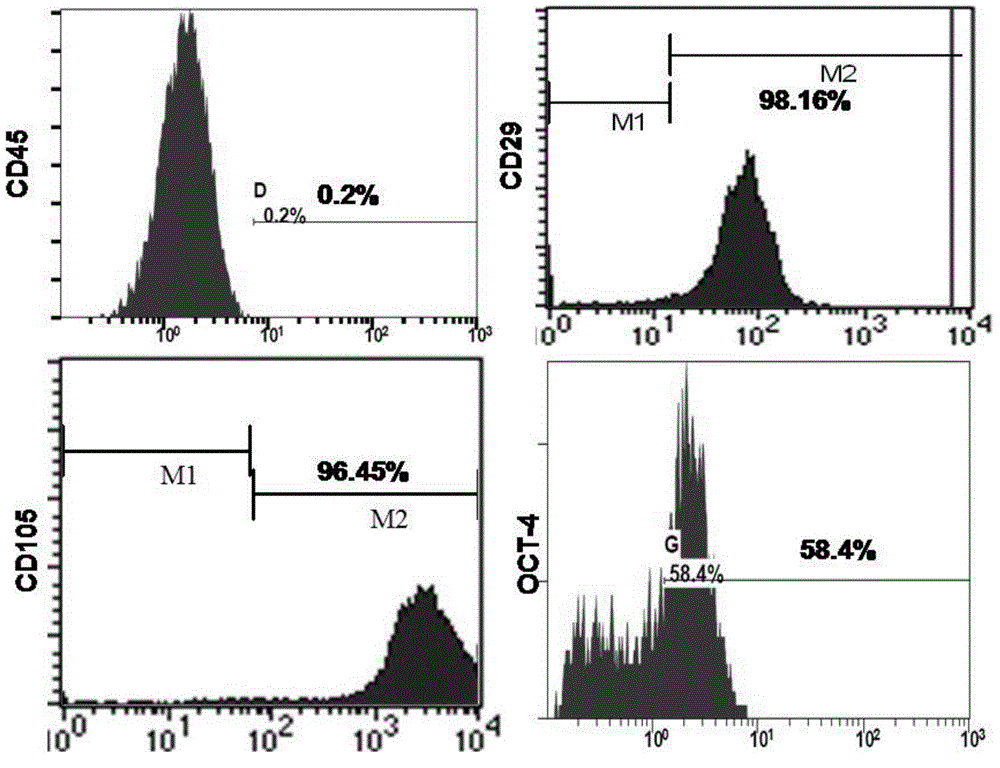Sweat gland differential induction medium and applications thereof
A technology of differentiation induction and culture medium, applied in the field of cell biology, can solve the problems of unclear key regulatory genes, inability to develop widely, and inability to prepare sweat gland differentiation induction medium, etc., and achieve stable and reliable results.
- Summary
- Abstract
- Description
- Claims
- Application Information
AI Technical Summary
Problems solved by technology
Method used
Image
Examples
Embodiment 1
[0035] 1. Isolation, culture and identification of umbilical cord mesenchymal stem cells
[0036] 1. Isolation and culture of umbilical cord mesenchymal stem cells
[0037] (1) After the fresh umbilical cord tissue was collected as medical waste with the informed consent of the patient, it was stored in a transfer box at 4°C in a sterile manner, and the umbilical cord with clip marks and congestion on both sides was excised within 6 hours part;
[0038] (2) Flush the periphery of the umbilical cord and the lumen of the umbilical vein with a phosphate solution (PBS buffer) containing penicillin (100 U / ml) and streptomycin (100 μg / ml);
[0039] (3) Then cut the umbilical cord tissue into 0.5-1.0mm 3 directly add 1g / L type II collagenase solution and incubate in a 37°C incubator for 16h;
[0040] (4) After washing the umbilical cord tissue with PBS solution, add 25g / L trypsin and continue to incubate in a 37°C incubator for 0.5h;
[0041] (5) adding a culture medium with a vo...
Embodiment 2
[0097] Isolation and identification of sweat gland cells
[0098] 1. Isolation and culture of normal sweat gland cells
[0099] (1) Place the skin in D-Hank’s balanced salt solution containing penicillin (100 U / ml) and streptomycin (100 μg / ml), rinse it 3 times, 5 minutes each time, to remove excess blood stains;
[0100] (2) Then remove the subcutaneous fat tissue, and continue to rinse repeatedly with D-Hank's balanced salt solution, each time for 5 minutes, to remove the residual fat tissue;
[0101] (3) Trim the skin into a microparticle skin with a diameter of about 0.5-0.8 mm by the method of making microparticle skin, add 3 ml of type II collagenase solution with a concentration of 2.5 mg / ml, and suspend the microparticle skin in the type II collagenase solution ;
[0102] (4) Then place the type II collagenase solution containing the skin particles in an incubator with a temperature of 37.5° C. and a humidity of more than 95% to promote the enzymatic digestion of the...
Embodiment 3
[0131] Preparation and Application of Medium for Inducing Sweat Gland Differentiation
[0132] 1. Preparation of Sweat Gland Differentiation Induction Medium
[0133] Group 1: Add the following components in the low-sugar DMEM medium: based on the volume of the low-sugar DMEM medium, the volume fraction of special grade fetal bovine serum is 10%, hemisuccinyl hydrocortisone 0.4 μg / ml, and rh-KGF is respectively 10ng / ml, 20ng / ml, 40ng / ml, 80ng / ml 100ng / ml, triiodothyronine 2nmol / ml, rh-EGF 10ng / ml, insulin-transferrin-sodium selenite solution 0.1ml / ml, penicillin 100U / ml, streptomycin 100μg / ml.
[0134] Wherein, the insulin-transferrin-sodium selenite solution comprises the following components: 0.01 g / L of insulin, 0.0055 g / L of human transferrin, and 0.000006 g / L of selenite.
[0135] Group 2: Add the following components in the low-sugar DMEM medium: based on the volume of the low-sugar DMEM medium, the volume fraction of special grade fetal bovine serum is 8%, hemisuccin...
PUM
| Property | Measurement | Unit |
|---|---|---|
| diameter | aaaaa | aaaaa |
| concentration | aaaaa | aaaaa |
Abstract
Description
Claims
Application Information
 Login to View More
Login to View More - R&D
- Intellectual Property
- Life Sciences
- Materials
- Tech Scout
- Unparalleled Data Quality
- Higher Quality Content
- 60% Fewer Hallucinations
Browse by: Latest US Patents, China's latest patents, Technical Efficacy Thesaurus, Application Domain, Technology Topic, Popular Technical Reports.
© 2025 PatSnap. All rights reserved.Legal|Privacy policy|Modern Slavery Act Transparency Statement|Sitemap|About US| Contact US: help@patsnap.com



